Buy AutoTrafficRSS script now for $27 only!
We will send the script to your PayPal email within few hours,Please add FullContentRSS@gmail.com to your email contact.Source: #Google to Provide Timely Information About Earthquakes
Buy AutoTrafficRSS script now for $27 only!
We will send the script to your PayPal email within few hours,Please add FullContentRSS@gmail.com to your email contact.Buy AutoTrafficRSS script now for $27 only!
We will send the script to your PayPal email within few hours,Please add FullContentRSS@gmail.com to your email contact.Everything you need to know about SEO, delivered every Thursday.

For those of you unfamiliar with him, Dr. Pete Meyers is a marketing scientist over at Moz. He is responsible for building the MozCast and likely as a byproduct of that has spent a lot of time examining all the different changes to Google SERPs.
Local and social have been huge parts of the constantly changing Google SERPs and will continue to be for the foreseeable future. The average SERP can have 5+ different features just as a rule, with the local pack, knowledge graph, AMP and in-depth articles being increasingly common.
In fact, mobile SERPs have moved so far away from the traditional 10 blue links, it's not even worth thinking of them in that framework anymore. And since Google seems to think they can offer a better and more information-rich mobile experience than in websites, that isn't likely going to change anytime soon.
Title tagsProbably one of the most salient points about SERP features for SEOs is the ever-changing title tag length. The number of characters appearing in search engine listings keeps changing. Additionally, Google continues to rewrite title tags in some cases, which could impact your click-through rate from search.
Dr. Meyers recommends to shoot for less than 60 characters, but don't obsess over it. Interestingly, most people assume mobile displays shorter title tags; however, listing titles are two lines on mobile, so they are often showing longer title tags.
New features look strongGoogle recently announced rich cards, "a new Search result format building on the success of rich snippets." Similar to rich snippets, rich cards use structured data markup to make SERPs more visually engaging.
While these are being rolled out slowly and to select industries, they highlight Google's continued interest in using structured data to create "better" SERPs. Google is trying to turn even unstructured data into SERPs features, and you can see these in answer boxes and other featured snippets. SEOs like to poke fun at all the examples where they do this wrong, but they are increasingly getting it right.
Speaking of the answer box, this is a powerful feature that can take you from ranking in position #10 to being the first piece of info on the SERP. Dr. Pete believes this is something all SEOs should be thinking about (I agree). When you change devices, answer boxes become even more powerful. For instance, they take up a significant amount of real estate on mobile, and if you are using voice search and there is a featured snippet, Google will read it back and source it from the website (e.g., "according to Moz").
Another relatively new feature is Accelerated Mobile Pages (AMP). With the continued growth of mobile search and ads, it makes sense for Google to continue to drive what they feel is a better mobile experience for their users. This illustrates Google's thinking when it comes to mobile first design.
With so many changes coming to Google's search results, it's helpful if you think of all these new SERP features and changes as "search units." It's important to see these as opportunities and look towards how you can get your (or your client's) company included in them. That will hopefully alleviate some of the doom and gloom!
See Dr. Pete's full presentation below:
Some opinions expressed in this article may be those of a guest author and not necessarily Search Engine Land. Staff authors are listed here.
About The Author Dan Leibson is the Vice President of Local & Product at Local SEO Guide, a boutique full-service SEO consultancy. He runs a department that specializes in local SEO for multi-location businesses, as well as, agency consulting. He is a huge craft beer aficionado & foodie and when he isn't contemplating how to best unlock the secrets of the Local SEO universe spends his spare time hanging with his wife and daughter.
Disclaimer: Every situation is unique. This outline of the elements of a content and onsite SEO audit discusses the common first points I look at with unpenalized sites hoping to increase their traffic. If you have a penalty or other serious issues, this list is not exhaustive and will not cover all the areas you will need to research or methods to employ.
Last month, I started my three-part series on conducting an SEO audit on your website. The purpose of auditing your site regularly is to ensure that you're not only protecting yourself against penalties or technical oversights, but that you're taking full advantage of the content you're providing (from an organic SEO standpoint in this context) and that you're "forcing" yourself to keep updated on shifts in users and terms as well as changes in the overall algorithms.
As mentioned, this audit is divided into three parts of which this is part two. Part three will be available in four short weeks. The parts are:
In today's installment, we're going to be looking at content and onsite SEO. Last month we looked at technical SEO to help ensure that the content is given the weight and credit it's due.
Of course, if that content is poorly optimized or if you haven't taken the time to properly research what people want or how they're looking for it a technically perfect site (if there's such a thing) will still not do you much good.
So let's dive right in and answer the question, "How do you make sure you have the right content optimized the right way?"
1. Understand the purpose(s) of your contentThe first step of the on-site optimization audit process is to divide your content into purposes and develop a strategy around each. A typical product or service site should have content geared towards one of the following three purposes:
To this end, it's the duty of every SEO or site owner to audit the websites they work on to ensure they have content geared to at least these three purposes. If you don't it's time to think about how to add it and what it should be. Which leads us to …
2. Keyword discovery
There is arguably no step in the SEO process more important than keyword discovery. Many SEOs will argue that we are not in a keyword-driven universe anymore, and whether that's correct or not, understanding what core terms have the highest volumes will guide the overall tone and wording of your website.
Keyword research will inform the targeting of key pages as well as let you know what you may be missing by illustrating terms that are searched that you may not have pages for.
There are a number of solid tools out there that assist in the discovery phase. My personal favorite presently is Moz's new Keyword Explorer; however, if you have a lot of research to do and you don't have a paid Moz account, it could get a little painful. In that case, you'll likely fall back to Google's Keyword Planner (which is still free for all users, despite recent rumors).
I tend to begin the process by querying every core term I can think of. In our example above, I would query "blue widgets" and perhaps just "widgets." I would then think a bit outside the box and query terms that relate to my subject but are outside the specific focus. In our example, that would be terms like "red widgets" or "imaginary products."
You then combine all your keyword data into one list, sort it by search volume, and start at the top. As you work your way down, indicate which of the three main types of content the term would be best suited to (I like using color codes).
Essentially, you're taking all the keywords relevant to your product or service (and related products and services) and choosing whether the content type would be best suited to a conversion, an informational or exploratory user, or link baiting.
The next stage is to simply prioritize your keywords based on their value to you, ensuring that you're building out a strategy that spans the three types of content your site needs and that you'll be working on all three constantly. You need to schedule the development of the new content and determine how it will be added to your site.
If it's informational or link/social bait, you'll need to map out how it will be deployed outwardly and how you will treat the traffic on arrival. (Is the content just there to provide information and reinforce brand, or is there a plan to move visitors into the conversion funnel?)
3. Ask aroundKeyword discovery is excellent in the crafting of a content strategy, but there will be holes — things you didn't think to look up.
Get your sales and support teams (even if it's just you) to document the questions they get asked, and research how you're addressing these questions on your site (if you are at all). If a prospect who picked up the phone to call or emailed is wondering about something, you have to consider how many people have left your site to find the same information (did they return?) or are leaving the sites of your competitors in search of the same answers.
Once you know the questions, it's a simple matter of researching keywords that might apply to a user in that stage of the conversion cycle and working it into your site. You'll generally want to make sure it's not just added to the site into a blog post, but rather as a functioning page or set of pages ("FAQs" or "Resources," for example).
This is because you'll want to make these pages available at other points in your conversion funnel where you might be losing people who are in search of more information. You want to keep them on your site, and you don't want them going to sections that will distract them from getting back to their task at hand (buying your product or service).
This stage of the content auditing process needs to be a constant work in progress. You can never be done listening to your users, and you can never rest from it.
4. Titles & descriptionsAt this point, you've redone your keywords as part of the SEO audit process. After figuring out which keywords make the most sense to target on which pages, it's time to get to auditing your on-site SEO. So let's talk titles and metas.
In the technical SEO audit piece, I referenced a tool called Screaming Frog. If you use it to crawl your site you'll be able to view in it all the titles and descriptions (among many other things) and organize them by length and view them all in a list. This gives you a quick-and-easy way to audit your whole site's titles and descriptions at once (for most sized sites) and figure out which are too long or too short and which simply don't read properly or attract the eye.
But how do you know which titles and descriptions are problematic, and how do you address them? Let's look at each individually:
Title tagThe title tag is the single most important element on your page from direct and indirect SEO perspectives. It's a heavily weighted page element as it's generally what appears as the title of a search result making it the most visible element from a search engine standpoint. Further, it impacts your clickthrough rate which there is debate over but I personally consider it an SEO factor.
The visible title tag length has changed over time but is currently 70 to 71 characters, up from roughly 50 to 60 depending on the character pixel width.
Ideal titles vary based on the content type but the quest should always be to limit the length to the visible length in the SERPs. Title tags that display in the SERPs ending with "…" drive me personally nuts as they're a sign that your marketing message did not get across. There's a reason American Express has selected the slogan:
American Express: Don't leave home without it
And not:
American Express: Don't leave home …
If you fail to get your marketing message or page subject into the character limits you need to rework the titles. Worth noting, I tend to make some minor exceptions for CMS driven sites that append the company name, especially if the company name is long. Not ideal but if your title displays with the incomplete "…" where the actual page title is fully displaying and just the full company name is not, that's not great but if it's the minority of site pages it's tolerable.
Another key rule with titles is to include your main keywords in them and preferably close to the front. For my blue widget site, I would likely title the homepage:
Buy Blue Widgets Online | SELwidgets.com
For an informational page, it might appear more like:
17 Tips for finding and buying the perfect blue widgets for your love | SELwidgets.com
Which would appear as:
17 Tips for finding and buying the perfect blue widgets for your love …
Ideally, you'd get your brand in, too — but at least the searchers will see the full title of the post, and you can save the branding for when they get to your site.
DescriptionsWhile the description tag has no direct SEO value it has significant impact on SERP clickthroughs and thus can be counted as an indirect factor. You have roughly 155 characters to play with.
The goal with description tags is to include the keywords in it to help ensure it's selected to be displayed as the description in the SERP result and keep it to the visible 155 characters. Past that, the only goal is to write compelling copy that describes the subject of your page and entices the user in.
Remember always to consider where the user is at in their decision cycle when writing descriptions. If the page is targeting informational or early-query terms, like "what are blue widgets," you want to invite users in with information, not a hard sell. If the page targets queries like "buy blue widgets," then the description should have a harder sell and focus on value propositions. A good description for each would be:
Query: "buy blue widgets"Description: Buy blue widgets online directly from SELwidgets.com. Free overnight shipping. Made in the USA. 10% Off until July 4th.
Query: "what are blue widgets"Description: What are blue widgets? Blue widgets are a fictional product with a rich history of use. Find out the origins, uses and evolution on SELwidgets.com.
Titles and descriptions have always been and continue to be a balance between keyword use and SEO and click-throughs. They need to focus first on the clickability and second on their SEO value. Without both the user approval and the search engine approval, neither will be fully successful, so a balance must be struck.
5. Heading tagsLet me get a major pet peeve off my chest: Heading tags are not formatting elements.
Let me repeat and be very clear for all the theme developers and designers in the house who don't yet know this…
Heading tags are page elements meant to separate content into sections. You can think about them like sections of a book. Here's how they break down:
There is one title of a book, just like each page should have one H1 tag. It has one purpose and is there for one reason. Give it an H1 that makes sense, put it prominently above the fold, and make it the first heading on the page. The title of a book does not come after chapter 2.
The additional heading tags should be nested inside each other according to their position in the hierarchy. Again, visually consider how a book is organized, and do the same with your heading tags. Here's an example of a proper setup:
Each tag nested inside one higher in the priority.
Headings should contain keywords where appropriate, but more important is to define each section. Let's look at a scenario relating to the informational blue widget page above:
There's a good use of "blue widgets," but the focus is on dividing up the page into sections.
For those wondering about the initial rant — many designers and theme developers use heading tags as formatting elements. That is, they create a style for a heading tag and then use that tag when they want text in that style, regardless of whether it's a heading of not.
This is a miserable thing to undo. So to any developers and designers in the crowd … please don't do this. And if you already don't (which explains why you're on Search Engine Land), please accept my sincere thanks.
6. Content optimizationInterestingly, the actual optimization of the content has gotten more logical and dare I say "easier" over the years. In the early days of SEO (let's call that any time before 2008) we targeted keyword densities. I still remember in 2004 knowing that 3.5% was an optimal level and if you hit it you were pretty much guaranteed a decent ranking as long as you had some type of link strategy in place. This made for horrible copy.
Thankfully Google's understanding of language has evolved to a point where it's not necessary nor desirable. This has made it easier for SEOs to write copy for visitors that the engine's will like. There are still guidelines to follow but they're far more natural.
When optimizing your content you need to obey a few specific rules. They are:
This might seem simplistic but it works. Focus on complete content that uses your keywords and terms related to your subject matter. Don't focus on keyword density, focus on the completeness of subject matter and user experience.
Now, we know how to optimize content but how do we audit it? That, unfortunately, is a task of time. You're going to need to visit each page and read it as though it were your first time there. Think about being a user and what they would expect following a link to your page and question whether you've fulfilled their expectations or just your own (and hint: you're not the person you're trying to win over).
Auditing content is arguably one of the longest individual stages of any campaign and in some cases where the site is too large, can't be fully completed.
If you have a very large site that makes auditing each page individually unreasonable or you have a blog with content that's a decade old and not visited then you'll likely want to focus more on auditing your relevant and visited informational and conversion oriented pages. Then you can simply let these rules guide new content pages as they are developed.
7. Image optimizationUsing your images to both build relevancy for general organic search and rank on image search is a fairly straight-forward but too-often-overlook area of SEO. Screaming Frog is again a fine tool for pulling image information quickly and putting it all in one place though you could audit your images manually one-by-one as you're visiting the pages to audit the content.
What you want to make sure you have done with your images is:
I mentioned above that at times a specific piece of content can be used for multiple purposes but often needs to be reproduced in a different format to do so. Take for example a piece on the history of blue widgets. If you were looking to add an informational and authoritative piece to your site on the subject it would probably look a lot like a Wikipedia article. Essentially you'd be creating a page with a lot of information structured effectively.
If you wanted to create social or link bait content out of this subject matter however you would need to create something simpler to digest and more visually appealing.
To that end you may turn the raw facts and data into an infographic or slideshare or, if you're Rand Fishkin, explain it in a Whiteboard Friday video and enjoy the default few thousand shares and links it'll get. Either way, you've only had to do the research once then produce the content multiple times which is generally the faster part of the process.
The purpose here is not to rank both for the same query but rather to rank each for the phrases their audience would be searching and further, to appeal to a different audience and purpose entirely. The video or SlideShare or infographic, for example, may never rank organically and may need to be nudged forward with some paid social or other manufactured push to start the ball rolling on acquiring the links and shares you're looking for where the informational piece would be more likely to rank organically.
In the end however, you'll have additional content that appeals to a different segment of your content purpose and because it's based on past research it tends to be faster to produce. When you can get wins across the board on user experience and SEO value you're in luck and provided the initial subject applies to more than one content segment/audience – repurposing is a highly effective method for getting more done faster but keeping the quality up when done right.
ConclusionAs mentioned above, specific scenarios require specific solutions but the points mentioned here tend to work across the board and apply to virtually every site.
Properly auditing, reviewing and rethinking your content isn't a silver bullet to the top positions but with the technical SEO squared away and now the content taken care of, next month we'll discuss link building and with all three in place you're well on your way if not already there.
I invite your comments and questions over on Facebook. If you have additional points you believe should be added that apply to everyone looking to optimize their onsite copy feel free to make note of it.
Some opinions expressed in this article may be those of a guest author and not necessarily Search Engine Land. Staff authors are listed here.
About The Author Dave Davies founded Beanstalk Internet Marketing, Inc. in 2004 after working in the industry for 3 years and is its active CEO. He is a well-published author and has spoken on the subject of organic SEO at a number of conferences, including a favorite, SMX Advanced. Dave writes regularly on Beanstalk's blog and is a monthly contributor here on Search Engine Land.Buy AutoTrafficRSS script now for $27 only!
We will send the script to your PayPal email within few hours,Please add FullContentRSS@gmail.com to your email contact.Buy AutoTrafficRSS script now for $27 only!
We will send the script to your PayPal email within few hours,Please add FullContentRSS@gmail.com to your email contact.We live in the age of personalization and customization.
Businesses are trying to find ways to personalize their services to better connect with overarching trends. With the Internet at your disposal, you can have a custom shirt with your dog's face on it and also get a shirt for your dog with your face on it.
This is just one example of the growing customization culture and interest for the weird that has cropped up, causing an uptick in the amount of Etsy stores out there.
As of 2014, Etsy had 54 million users —up from just 5 million users in 2004. 1.4 million of these Etsy users are active sellers. As more Etsy stores pop up, the space becomes more competitive.
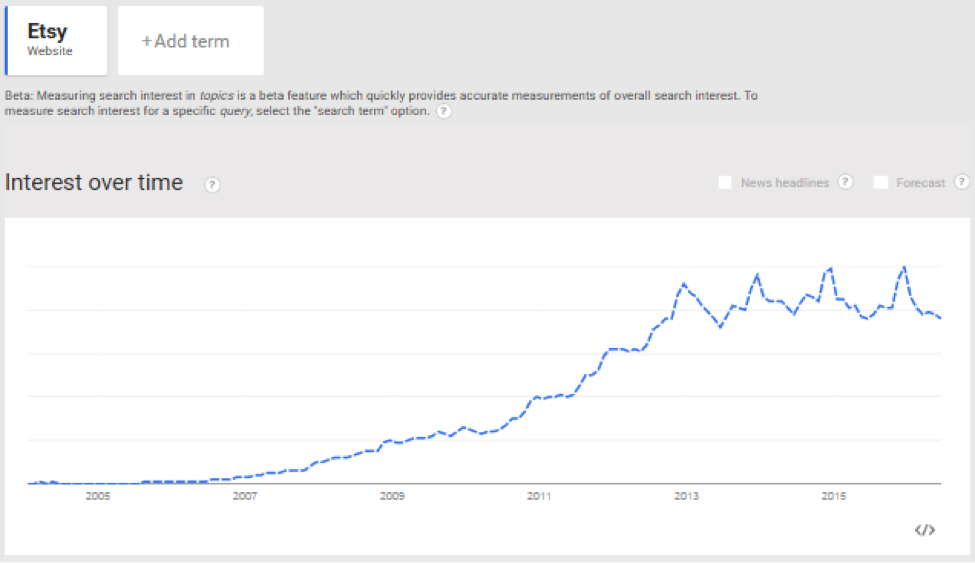
Optimizing your Etsy store and products will help you stay visible whether customers search on Etsy or Google. Here are the fundamental tips and tricks to help enhance your Etsy store and product listings to increase traffic from Google to drive sales.
Etsy keyword researchHaving an understanding of your customer's keyword for your own business is beyond powerful and can help potential clients and fans find you.
Marmalead is a great tool to find keywords for Etsy shops. With it you can type in a tag (or keyword) and see total results or competing products and shops, total views, average views per week, average favorites per week, and much more. F
or a more in-depth explanation of this tool and how to use it for keywords, check out the Ultimate Etsy SEO Guide on Marketing Artfully.
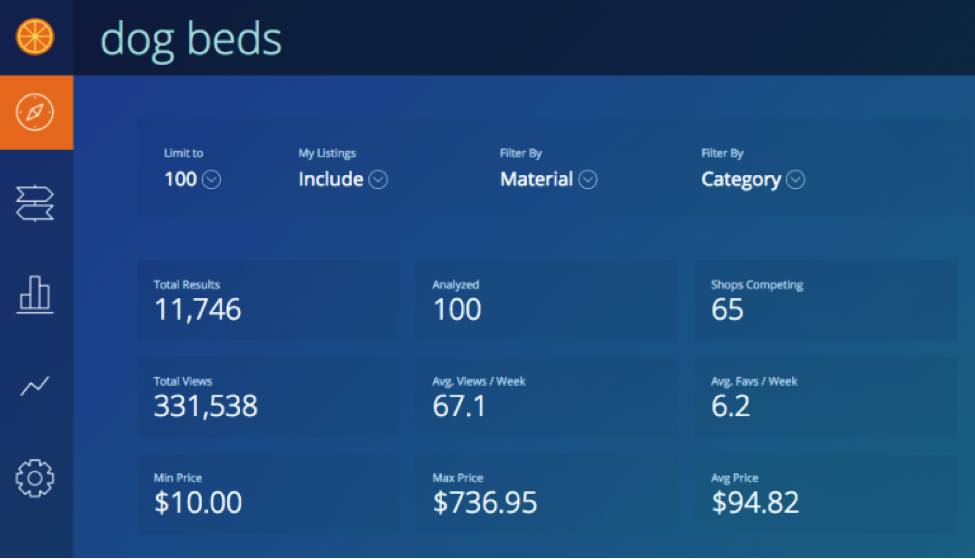
Another free option to find keywords for your business – whether you're a painter or sell custom koozies – is the Google Keyword Planner Tool.
In the Keyword Planner, you can enter one or multiple keywords and Google will tell you a rough estimate of how many searches there are a month, the competition, suggested bid (if you were running an Adwords campaign), and related keywords.
This provides insight as to how people are searching for products related to what you offer.
Let's say you sell celebrity prayer candles, which I hope you do. Instead of using the keyword "celebrity prayer candles", you can also try "celebrity candles" or even "funny prayer candles."

Although "celebrity prayer candles" may be your exact item there is an opportunity to take a top spot for "funny prayer candles" since no shops are currently optimized around it (see screenshot below).
Choosing keywords that have lower search volume, less competition, and are specifically related to your products may be better choices to pull in relevant traffic.
Slight variations in keywords can make all the difference, and having keywords at your disposal is great ammunition, whether you have an Etsy shop or a blog on a WordPress site. You need to know what people are looking for and how to reach them.
Make sure to keep a list of applicable keywords ready whenever you are creating a new product listing.
Optimize your Etsy shop for Etsy and Google… but also your customersYou've got those awesome keywords at your disposal. Now it's time to use them!
The coolest thing keywords can do is show you how people are actually searching for your items. Instead of guessing in the dark, you can use terms that potential customers are using to find your products.
Optimizing both your shop and products are essential to being found on Google and to have people click through. Let's return to our favorite prayer candle example.
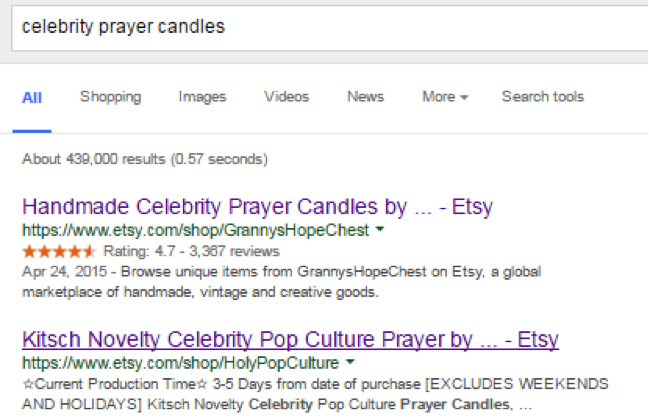
Above are the top two results for 'celebrity prayer candles'. The first result has a meta description that is the proper length and tells you about the business, but the business name is cut off from the page title.
On the other hand, the second result has the business name in the page title (but before the keyword) and the meta description is loaded with too much information and is not succinct.
A page title should be max 65 characters and the meta description should be a maximum of 140 characters. Your page title/store title should quickly summarize what your business does and its name.
A better page title for the first Etsy store might be "Celebrity Prayer Candles | Granny's Hope Chest". This title is short, but lets you know what the store offers and what it's called.
A great tool to preview what your shop title and announcement will look like is the Google SERP Snippet Optimization Tool.
Optimize your Etsy product listingsIf you're trying to move specific product on Etsy then you need to optimize: 1. title description, 2. tags, 3. the first sentence of the product description, 4. categories and materials.
Google pulls this information to create what shows up in search engine result pages, so optimizing properly can help boost traffic on specific products.
The Etsy product title is what Google uses for your listing's title tag, H1 tag, and image alt tag for each page so make it informative and keyword optimized.
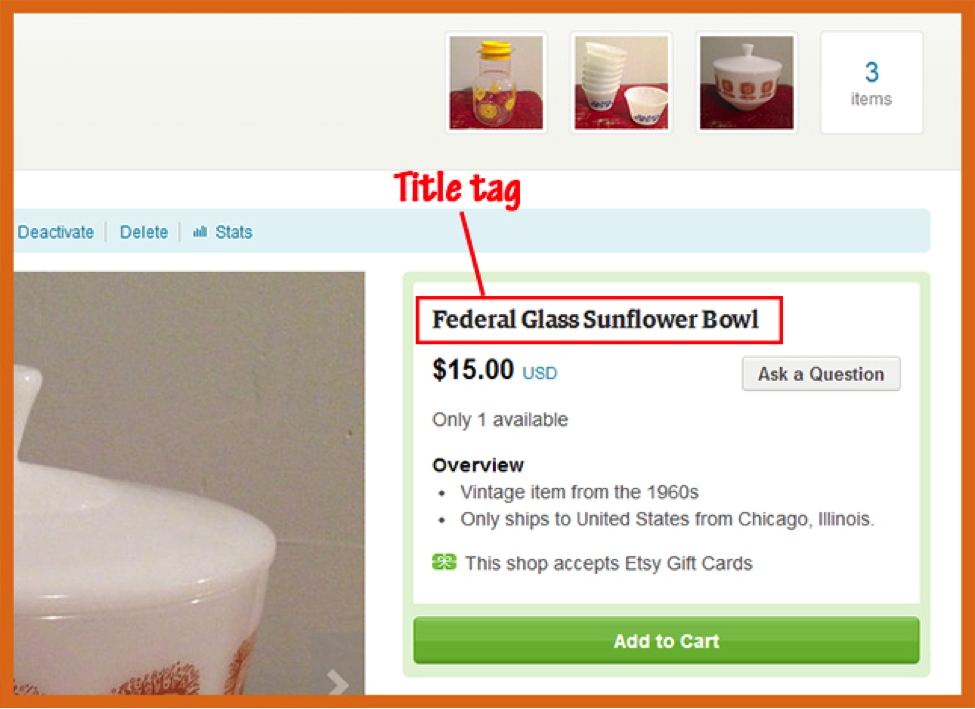
Scott Taft does a great job of further explaining how your Etsy store translates on Google.
Let's say you not only create celebrity prayer candles, but you really kick it up a notch and specifically create Steve Buscemi prayer candles.
Yes, there are an average of 30 searches a month for "Steve Buscemi Prayer Candle," according to Google Keyword Planner. Since Buscemi prayer candles are a little more popular than you would imagine, optimizing your product listing for both Etsy and Google can make a big difference in separating your Steve candles from the rest of the celebrity candle pack.
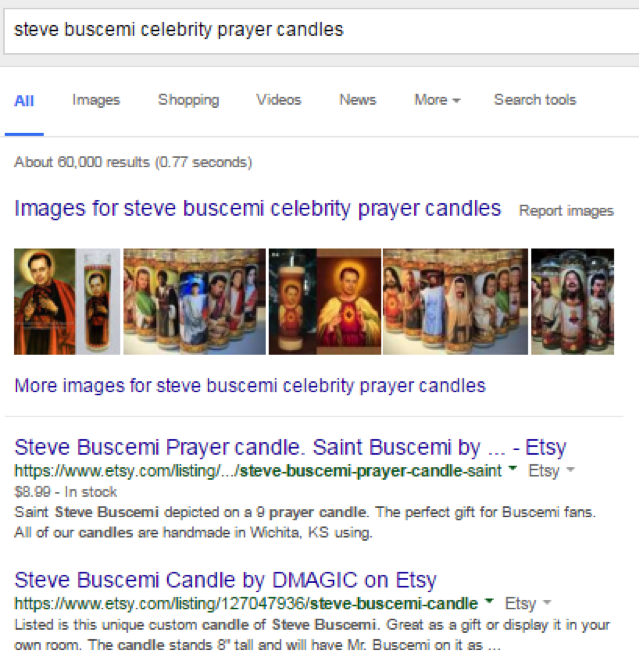
Again, make sure your product title uses a keyword before your business name and is 65 characters or less.
In this case, if someone is looking for a Steve Buscemi prayer candle then chances are they have a pretty good sense of humor, so your product description should be written to draw a potential customer in with witty copy.
The meta description pulls the first sentence from your product description (as Scott Taft points out in the image below). Remember to make the sentence close to 120 characters and include the same keyword from your page title, if possible.
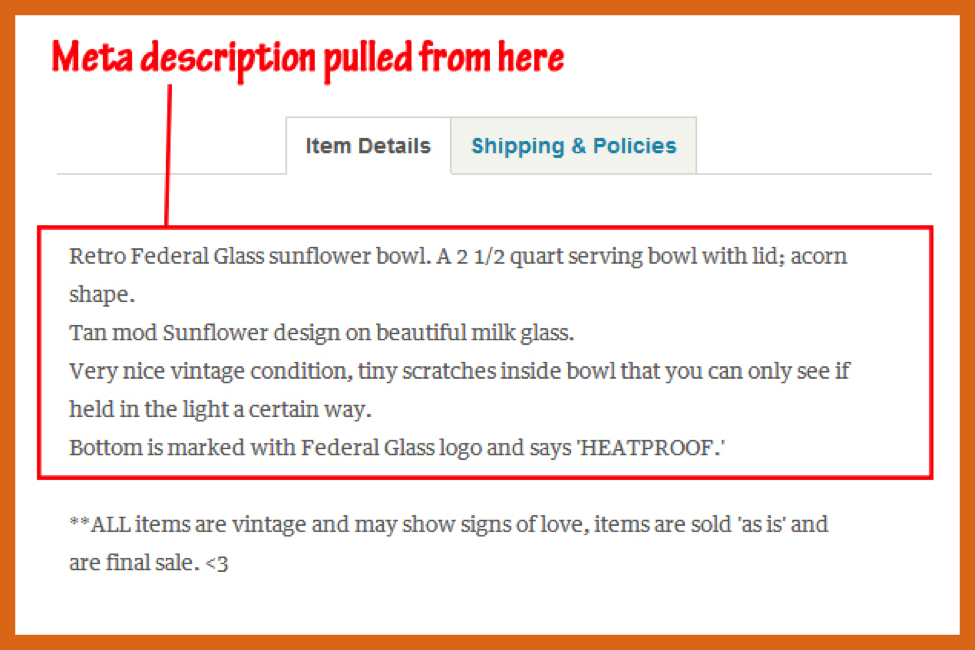
Using the keyword 'Steve Buscemi prayer candle', I created a keyword-focused page title and meta description that is clear, concise, and may appeal to Buscemi fans. The page title/title description is 55 characters and the product/meta description is 116 characters.
Creating Etsy product titles/page titles and meta/product descriptions that are keyword focused, informative, and fun can help an artist stay visible on Google.

Implementing a keyword strategy may seem confusing and monotonous at first, but it will eventually become routine and is sure to yield results.
Understanding how people search for and see your shop and products is essential to performing well as the customized market grows. When it comes to SEO, try to think like a human first and a search engine second.
No matter what you're selling, take a few minutes to think about how you would be searching for your product on a search engine and then use the tools and tips to create a strategy. A competitive space isn't a bad thing when you understand your audience and how to reach them.
Maddie Silverstein is an SEO Analyst at DigitasLBi and a contributor to SEW. You can connect with Maddie on Twitter: @maddigler.
Related readingThe F-shaped pattern has been the commonly understood way in which web users browse sites and search results.
The challenge of how to 'speak' search engine and tell it how to surface our content is what Search Engine Optimisation is all about. But are we doing it as well as we could?
Google recently released Magenta, a computer based system that has the ability to create pieces of music.
In 2015, Google announced that for the first time ever, it was seeing more searches taking place worldwide on mobile devices than on desktop.
Buy AutoTrafficRSS script now for $27 only!
We will send the script to your PayPal email within few hours,Please add FullContentRSS@gmail.com to your email contact.Buy AutoTrafficRSS script now for $27 only!
We will send the script to your PayPal email within few hours,Please add FullContentRSS@gmail.com to your email contact.What is a title tag and how do you write one? Why are they important? Do they actually help with SEO? Can I see some examples?
In this post I'll follow up the advice on title tags and answer all of the above questions.
For the rest of you, first lets talk about meta tags in general:
What are meta tags?Meta tags are HTML elements that provide information about a web page for search engines and website visitors.
These elements must be placed as tags in the <head> section of a HTML document. These elements are:
We've discussed how to write meta descriptions in a previous post, so for now let's discuss title tags, the most important meta tags on your site.
What is a title tag?Title tags are used to tell search engines and visitors what any given page on your site is about in the most concise and accurate way possible.
This title will then appear in various places around the web, including the tab in your web browser. It's visible when you mouse over the tab.

The title is also likely to be pulled in as the anchor text when sharing on other websites and social media channels.
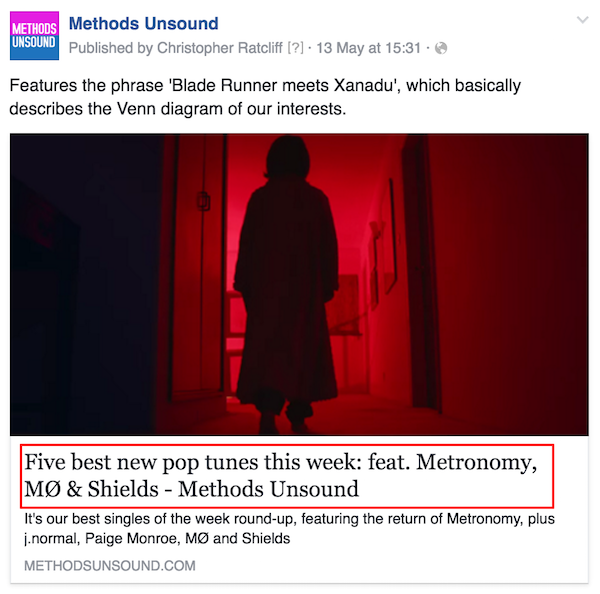
Most importantly of all, your title tag will show up as the big blue link on search engine results pages:
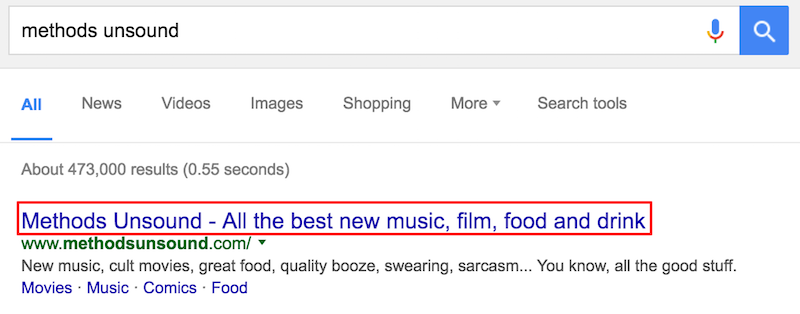
You can add the title tag in the <head> section in your site's HTML.
It should look something like this:
<head><title>Example Title</title></head>
However in most content management systems (CMS), including WordPress, you can either add a title tag in general settings:
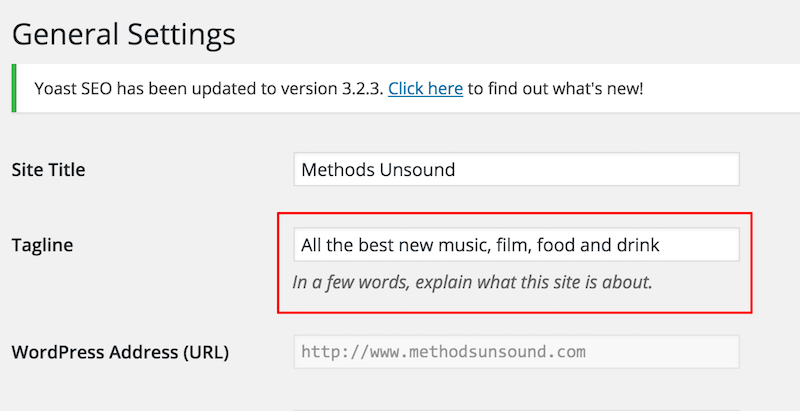
If you use an SEO plug-in, such as Yoast, you can add a title tag to the 'SEO title' section, and preview an example of how it will look in the SERPs:
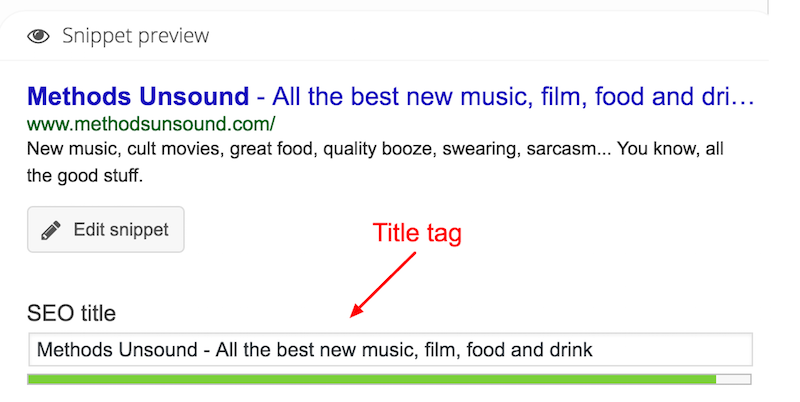
When writing an article, the section where you write a headline will automatically form the title tag for you.

If your title tag is automatically generated from the headline, you should try to override this by using either a plug-in (like the one mentioned above) or alter it in the HTML itself.
The headline (also known as the <h1> tag) is another opportunity to tell Google about the content of your page using a slightly different keyword string, so you may as well take advantage of this.
Why are title tags important?They're important because the title tag is the boldest, most obvious element in a search result and as such it plays a major part in the searcher's decision to click on your result or not.
Are title tags used as a ranking signal?According to Moz, title tags have "long been considered one of the most important on-page SEO elements." The closer to the start of the title tag any given keyword is, the more likely it will be to rank for that keyword based query.
How to write a great title tagFrom an SEO point of view, the title tag should contain all the keywords you wish to rank for. Also, as I mentioned above, the most important keyword should be at the beginning, followed by second most important, and finally your brand or website name.
Moz provides this handy reference:
Primary Keyword – Secondary Keyword | Brand Name
However one thing you must remember: write title tags for humans.
Although they should be formatted to some degree for search engines, it's vital that the tag makes perfect sense to humans and reads like a legible sentence.
Title tag checklistHere's a handy checklist…
Sometimes, if Google doesn't like your title tag, it will rewrite it for its search engine results, pulling in information from your meta description and page content.
It's likely that this won't be as good as the one you've created, so it's important to ensure that your own title tag is relevant, descriptive and keyword rich but also readable and the right length.
Good examplesHere are a few examples which follow the 'rules' in our checklist and therefore look more appealing on the SERP.
'best burgers in london'Esquire has all three keywords right at the beginning of the title tag, and then follows this with a seductively appealing headline and cleverly uses 'buns' in order to avoid repetition and keep the character limit to around 60.

Keywords are at the front, the brand name is at the end and Schuh has separated its keyword phrases with pipes | This used to be a necessity when writing title tags as the recommendation was to stay away from other punctuation.
This is no longer true, but pipes still look great on the page and help to make the title tag more easily readable.

Pitchfork has stayed away from a mistake that mine and other review websites make in putting 'review' at the start.
This is because searchers do not start their search queries with 'review', they generally start with the artist.

Using the same search terms as above, here are some bad examples of title tags:
'best burgers in london'This is buried far down on page four of Google and it's easy to see why.
The brand name and important keywords are the opposite of where they should be. The headline itself also lacks any description or anything vaguely persuasive to make me want to click.

The keyword is nowhere to be seen. It's probably at the end of the title tag, but because it's so long it has been cut out by Google.
There's also the wilfully inconsistent capitalisation, which can make the link look really spammy.

In this example from Mashable, the stop words at the beginning of the title tag push the important keywords into the middle and this result languishes on page four of Google.
The headline's great, but the title tag is identical, so perhaps all the wording of the title tag needs is a slight reordering.

With the share of digital ad spend at 29.9% in 2015 and expected to increase to 39.3% in 2019* the digital advertising ... read more
Google's dominance of the search market looks set to continue for the foreseeable future, but there are many who would like a real ... read more
Seasonal events which can deliver relatively short-term traffic spikes, need to be planned for from an SEO perspective. It's about being in ... read more
Last month, ClickZ Intelligence published its report into 'The State of Mobile Advertising', in partnership with Search Optics. Among the report's findings ... read more
By Kristopher Jones
Over the last 17 years, I've helped thousands of entrepreneurs and businesses generate more web traffic and sales through search engine optimization (SEO). As founder and former CEO of Pepperjam, which was sold to eBay in 2009, and current CEO of LSEO.com I've seen the industry from a lot of perspectives and I've learned that there are some basic SEO questions that all business owners must answer.
According to Internet Retailer, the growth of e-commerce was up 14.6 percent in 2015. As this trend becomes more prevalent, so too does everyday business chatter centered around SEO. But sometimes - especially for small-to-medium sized businesses that have legacy clients from a strong local brand (think restaurants or auto shops) - the term "SEO" delivers the purest form of dread.
Some people might have gotten ripped off by a hack SEO agency, and now refer to everything SEO-related as a scam. Then there are the ones who simply say SEO is dead, and their online presence can do without it.
But there's no doubting it - the higher your business ranks in Google, Bing, or Yahoo, the stronger your business will be. SEO ensures that customers can easily locate and index your website's pages, and ultimately serve the potential customer in an effective way.
Before you either seek out a reputable agency or work on SEO in-house, take a look at these simple questions to make sure you're on the right track.
Is My Content Diversified?
Is the bulk of your content simple text and a few photos? This is the case for many, but one must think like an investor who knows a diverse portfolio is key to achieving success. A well-diversified website contains a lot of content, mainly text in the form of product copy, blogs and reviews, along with photos, videos and infographics.
But you must make sure each one is optimized. Are you using the proper keywords in your headlines and copy? Do your photos contain descriptive ALT text and captions to keep visitors engaged? Did you compress your videos and PDFs to make sure site speed is on target?
Are My Technical/On-Page SEO Metrics Finely Tuned?
Start with technical metrics. Are your hosting configurations tuned? Most hosting companies like GoDaddy or WPEngine offer free support, and you can ask them simple questions such as, "How's the overall health of my hosting configurations?" They may find something simple that will vastly improve your website.
Also, there are various online tests to help check the site speed. Analyze the basics of on-page SEO, such as page titles (Do you have correct/catchy keywords?), URL length/structure (Are there keywords up front? Are they fewer than 512 pixels?) and meta descriptions (Is the marketing message clear?). A tool like onpage.org can help.
How About Visitor Metrics?
Every business should understand how to read its Google Analytics report. There, you can find some crucial visitor metrics that can help you optimize your site - both from a content and a technical perspective - to garner more traffic, and ultimately more sales.
Here are the top metrics you should be studying:
Visit every page and ask yourself this very question. Think like an editor, and only have the most trustworthy and authoritative content on your site. Solve problems. Add value. Did you check all the facts? Would readers view it like it was written by an expert in your industry? If not, revise accordingly.
Grammatical errors and false facts can immediately dethrone your authority. Look at the page from a designer's perspective, and make sure the layout is crisp and easy on the eyes - especially on mobile, which is surpassing the desktop as the viewing platform of choice.
Well-written, trustworthy and authoritative content naturally becomes linkable assets, which helps build the holy grail of SEO: backlinks. When other reputable sites link to yours, search engines see your site as authoritative, thus increasing its ranking in SERPS. This is a solid content strategy for obtaining links from places like industry-relevant sites, directories, press releases, .edu sites and social media.
Answering these questions is the first step towards bringing your website to the top of SERPS, which will not only help grow sales, but also play a fundamental role in building brand awareness.
Kristopher B. Jones is a prominent internet entrepreneur, investor, public speaker, and best-selling author. In 2008 Kris wrote a book on Search Engine Optimization that is currently in its third print for Wiley (2008, 2010, 2013) and has sold nearly 100,000 copies. Kris is the founder and former President and CEO of Pepperjam (sold to eBay), managing partner of KBJ Capital (13 companies), and the founder and CEO of LSEO.com and APPEK Mobile Apps.